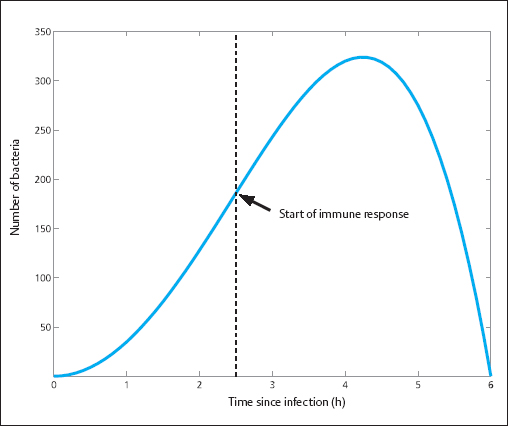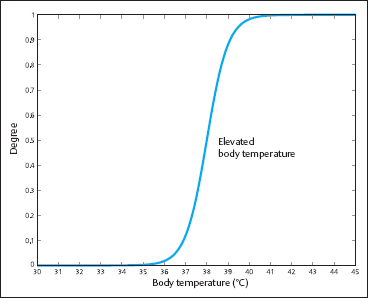 5 Expert Systems in Complementary Oncology
5 Expert Systems in Complementary Oncology
 Introduction
Introduction
The human organism is a highly complex system with an intricate network of various interrelated causes and effects. Diagnosis, prognosis, and therapeutic planning require a high level of medical expertise and experience. Due to the complex effects a disease exerts on the human organism, it is generally necessary to sift through of a lot of data in order to provide a good diagnosis and prognosis in any individual. Accordingly, the physician uses an extensive set of rules herein.
The evaluation of such medical data is increasingly supported through adaptive diagnostic systems based on mathematical models. In order to apply mathematics in a sensible way, a mathematical model of a section of the reality one wishes to work on is required. A mathematician might emulate the growth of bacteria in culture after an infection in otherwise healthy individuals. This model would in this case be a function or graphic depiction illustrating the time dependent amount of a type of bacteria observed in the blood after an infection present in a certain person. Such a function might look as shown in Fig. 5.1 (the units in the graphic are chosen arbitrarily). The progression of this function, e. g., time until the start of the immune response, was calculated by the mathematician by taking mean values of lots of data points. The model of bacterial growth obtained in such a way would, of course, be very simplistic, since it would be independent of other parameters like the person’s age or the individual characteristics of the immune system.

Fig. 5.1 Model for bacterial growth following an infection.
Mathematical modeling is often a complex, longwinded interactive process between experts from within the context of application and the mathematicians producing the model. Once a model is found it is evaluated and analyzed using mathematical methods. Nowadays the computer plays a large part in this. Without it, many of the models would be far too complex and therefore useless. In the evaluation, visualization is often the initial step for translation back into the specific context of application. This entire process is referred to as simulation—its computational part as scientific computing.
 Mathematical Contribution to Diagnosis and Therapy
Mathematical Contribution to Diagnosis and Therapy
The diagnosis and therapy of diseases can be conceived as regulatory processes. In individual diagnosis, information on the actual disease state is achieved initially by assessing the medical history of and by questioning the patient, and also through a set of targeted procedures such as radiography and computed tomography or ultrasound. This information serves as the foundation upon which the physician, using his knowledge and experience will come up with a diagnosis and initiate therapeutic measures.
Expert systems can now be of manifold value in the diagnostic and therapeutic setting. A well-functioning expert system can guide doctors to the correct diagnosis by delivery of concrete suggestions for diagnosis, as well as supporting accumulation of the physician’s own experience. In other instances, a different group of doctors can play a part in the development of an expert system—knowledge can thereby be integrated and made objective.
Expert systems and data mining are pillars that provide the basis for computer-supported medical diagnosis and therapy, which has been gaining considerable importance in recent years. This novel medical field requires the intensive and interdisciplinary collaboration of physicians, mathematicians, computer specialists, physicists, and engineers. In addition to utilizing previously existing medical information more effectively, and learning from it through combination with medical expertise, expert systems could serve as integral components of a system that is yet to be constructed, consisting of interlaced medical data banks that would be provided online for physicians for diagnosis and therapy.
 What is an Expert System?
What is an Expert System?
One example is the “Mycin” system developed in 1972, which helps the physician choose the type and dose of antibiotics. This system is made up of three main components:
• Consultation component After insertion of patient data and data pertaining to, say, the bacterial types detected in the blood sample, the system proposes an antibiotic for therapy, including suggestions for dosage. It is crucial to understand that data fed into the system may be vague: in this case, a morphological description of the organisms found in the sample can be given. The system tries to identify these through combination with other information.
• Explanatory component Following suggestion for therapy, it can be revealed which data and information was used.

Fig. 5.2 Structure of an expert system.
• Acquisition component This component enables new expert knowledge to be integrated into the existing system, or current information to be edited. Entering new information does not require any knowledge of programing, and can be done entirely by the expert.
The structure of the “Mycin” system is prototypical for an expert system. Generally the structure is as shown in the depiction shown in Fig. 5.2, the components of which are to be described shortly. The arrows in the diagram symbolize the flow of data and the direction of flow.
The knowledge of a (medical) expert consists of data and rules, in which the handling of information is defined dependent on specific situations. Data are, for example, the characteristics of bacteria or the effects of certain medications. Accordingly, the fact that certain bacteria can be treated with certain medicines can be defined as a simple rule.
This perspective of expert knowledge is referred to as rule-based approach and is used throughout the entire chapter. An alternative is the so-called object orientation, in which data and rules are conceptualized as more abstract objects combined.
When considering integration of expert knowledge into a computer program two problem areas should be addressed:
• Data structures must be developed that are well suited for storing and retrieving human expertise—this occurs under the keyword knowledge representation. The problems surrounding knowledge representation and their possible solutions cannot all be mentioned here, but will be described briefly below, see p. 58, under fuzzy logic, as a possibility of implementing knowledge.
• In association with the implementation of knowledge is its formalization: expert depictions of existing knowledge are generally too complex to be directly implemented into respective software. This is due to the complex nature inherent to language itself, but often also due to lack of formal structure. Therefore, before input into the expert system, relevant knowledge must be represented by means of a simple formal language. Ideally, the expert himself performs this translation process. This is especially important, since expert systems should be designed in order to be customized by the user: completeness of knowledge in a certain area can not be expected. This implies that the knowledge can be modified, updated and expanded using a software module, a so-called data and rule editor. Input via this editor ensues in the mentioned formal, but easily written and readable, language. Above all, system users are not expected to have any programming knowledge.
The actual simulation of experts—the query of a specific situation within the area of expertise of the system—occurs through the consultation module. Following entry of data describing the situation, the interpreter analyses these, and compiles the rules needed, then applies these and finally displays the result in a user friendly manner.
Typically, the entered data are not precise. The interpreter must be capable of dealing with poorly delineated situations. Contrary to knowledge, strategies for entry-dependent collocation of the rules are permanently integrated within the system, or more precisely, in the interpreter, and cannot be altered by the user.

Fig. 5.3 Example of a fuzzy set.
For various ends, it is necessary to fully understand the route from given input data to output data within the expert system: controllability of the system should be mentioned, as should applications in expert training or the test of newly to be integrated knowledge. A structured depiction of the routes from entry to output offers a module for reconstruction of decisions.
 Uses in Medicine
Uses in Medicine
The use of expert systems in medicine does not differ much from that in other specialist areas. The following formulated areas of application can easily be transferred to other fields.
• Relief for the doctor of performing routine tasks The expert system can take over the classification of patient data for diagnostic purposes, including concrete diagnostic suggestions for the physician. A further field of application is the choice of a specific therapy, oriented according to the individual circumstances of a particular patient.
• Improved availability of medical expert knowledge An expert system can be used, among other things, as a specialist book or databank. The internet allows the functionality of expert systems to become available to the wider general public who in turn can use it to improve their health-related behavior and the surveillance of their own health.
• Support of medical education A complete expert system provides the user with the option of retrieving explanations for specific conclusions, arrived at by the system in a particular situation. The user can compare his conclusions with that of the system and, if necessary, correct them. Medical models are becoming increasingly realistic through interconnection with expert systems.
• Objectifying knowledge using formalized depictions The construction of an expert system requires clear and formal depiction of existing subjective knowledge on a particular circumstance. This enables knowledge to be comprehensible and traceable enabling full utilization of functionality of the expert system. The collaboration of multiple experts on a system makes this approach very effective.
• Facilitation of validation of knowledge or rather verification of hypotheses.
Since the demands that medicine places in terms of complexity and operational reliability are considerably higher than in the technical–scientific area, a warning should be given: none of the above mentioned points should be misinterpreted to the extent that competency of a medical expert can be replaced by a computer program.
 Fuzzy Logic
Fuzzy Logic
Stay updated, free articles. Join our Telegram channel

Full access? Get Clinical Tree


